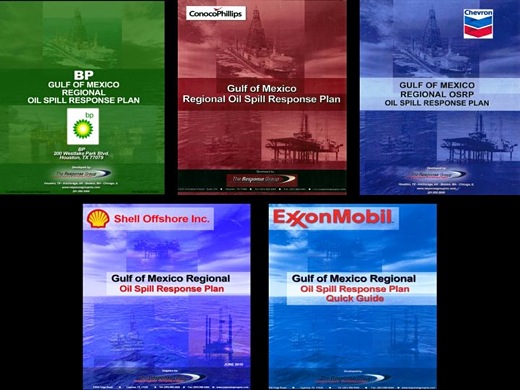 Image above: Cover pages of Spill Response plans of BP, Chevron, Shell and Exxon, even share background clip art. Talk about cheating on homework.
Image above: Cover pages of Spill Response plans of BP, Chevron, Shell and Exxon, even share background clip art. Talk about cheating on homework.
By Jennifer Dlouhy on 15 June 2010 for the Hoiuston Chronicle - (http://www.chron.com/disp/story.mpl/business/7054419.html)
The chief executives of America’s biggest oil companies on Tuesday distanced themselves from the environmental catastrophe in the Gulf of Mexico, with three insisting they would not have drilled the leaking well the way BP did.But lawmakers on a congressional subcommittee were skeptical, noting that the companies rely on “cookie-cutter” plans for responding to spills — with nearly verbatim safety assurances.
Exxon Mobil CEO Rex Tillerson fueled the congressional criticism by confessing that the industry is outmatched when it comes to oil spills.
“When these things happen, we are not well-equipped to deal with them,” he said. “That’s why the emphasis is always on preventing these things from occurring.”
As public and official outrage continued to grow along with the disaster, Tillerson — along with the heads of the other four top U.S. oil companies, BP America, Shell Oil, Chevron and ConocoPhillips — took a grilling from lawmakers at a highly charged House Energy and Commerce subcommittee hearing.
While the executives fielded questions on Capitol Hill, President Barack Obama wrapped up a two-day visit to the Gulf Coast and later addressed the spill in his first-ever Oval Office speech.
Design criticized
The design of the well at the center of the disaster drew criticism Tuesday from the executives of Exxon Mobil, Chevron and Shell, who said they would have planned and drilled it differently.
Tillerson said the BP well violated design standards that are the industry norm.
“We would not have drilled the way they did,” he said, adding that he was puzzled why people working on the BP well made “decisions that almost any of our drilling operations people would have made differently that led to the ultimate loss of the well.”
Chevron CEO John Watson and Shell Oil President Marvin Odum also said the well fell short of their companies’ standards.
“It is not a well that we would have drilled,” said Odum, who runs the Houston-based U.S. arm of Royal Dutch Shell.
BP America Chairman Lamar McKay, Odum’s counterpart with London-based BP, emphasized that investigations are still under way to determine what happened April 20.
They probably will reveal a combination “of decision making, processes and equipment that interplayed to allow this to happen,” McKay said. “To my knowledge, the well design is not an unusual design for the Gulf of Mexico.”
‘Carbon copy’ plans
Lawmakers excoriated the companies’ nearly identical spill response plans, which they said were fresh evidence that the industry is ill-prepared to deal with out-of-control wells.
Rep. Ed Markey, D-Mass., said the plans tout ineffective equipment, rely on nearly identical safety assurances and make similar references to protecting walruses, “which have not called the Gulf of Mexico home for 3 million years.”
Rep. Henry Waxman, D-Calif., said the “carbon copy” plans undermined the executives’ assurances that they are following rigorous standards on offshore rigs. “Exxon Mobil, Chevron, ConocoPhillips and Shell are as unprepared as BP was,” Waxman charged.
“BP failed miserably when confronted with a real leak, and one can only wonder whether Exxon Mobil and the other companies would do any better,” he said.
Rep. Bart Stupak, D-Mich., said Exxon Mobil’s response plan includes a 40-page appendix devoted to how it will deal with reporters after an accident — compared with five pages on the plan for protecting resources and nine pages dedicated to oil removal.
Exxon Mobil has “meticulously anticipated virtually every conversation that the company might need to have with the media in the days following an oil spill,” Stupak said, but “has given far less attention to actually controlling a spill.”
Rep. Joe Barton of Ennis, the Energy and Commerce committee’s top Republican, said the failure of a key safety device called a blowout preventer at BP’s well shows the industry cannot afford to rely on the devices as the last defense against runaway oil and gas.
“You can’t have a contingency plan that says cross your fingers and hope the blowout preventer works,” he said. “We need more than a cookie cutter contingency plan.”
‘High degree of mistrust’
Rep. Sheila Jackson Lee, D-Houston, said BP’s problems mar the entire energy industry.
“There is certainly a high degree of mistrust by the American people” about the industry, Jackson Lee told the executives. Asserting that “most of America has no stake in the energy industry” and looks at it from a distance, she challenged the executives to convince Americans that the companies are part of national security.
Lawmakers berated the oil CEOs for spending more on advancing drilling technology to extract oil from deeper and more remote locations without devoting similar attention to improving decades-old spill response technology.
The heat will continue for BP executives, as CEO Tony Hayward and Chairman Carl-Henric Svanberg are set to meet with Obama today for the first time since the oil spill began. Hayward is set to make his first appearance on Capitol Hill on Thursday, before a House Energy and Commerce subcommittee scrutinizing the spill.
.
No comments :
Post a Comment